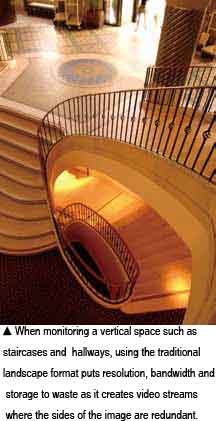Access Control
 Tracking the whereabouts of guests, staff, visitors and vendors is made more accurate and secure with advanced technologies like RFID. “Hotels have shifted toward RFID-based, contactless card technology from the traditional magnetic-stripe electronic locks, because it offers additional security layers and anti-cloning technology for both guest and staff cards,” Venas said. “RFID allows hotels to track their employees and improve management and efficiency. With RFID, hotels now have a platform to mount multiple applications onto the same card, creating better valueadded services for their guests within a more secured environment.”
Tracking the whereabouts of guests, staff, visitors and vendors is made more accurate and secure with advanced technologies like RFID. “Hotels have shifted toward RFID-based, contactless card technology from the traditional magnetic-stripe electronic locks, because it offers additional security layers and anti-cloning technology for both guest and staff cards,” Venas said. “RFID allows hotels to track their employees and improve management and efficiency. With RFID, hotels now have a platform to mount multiple applications onto the same card, creating better valueadded services for their guests within a more secured environment.”
Wireless technology is also employed in hotels to connect all electronic locks to the central server, providing ease of holistic management, Venas added. “Room doors, corridors, conference rooms, parking lots, back alleys and office doors can all be wirelessly connected to the central server; therefore, canceling master cards, changing access parameters on the go for guests and staff, and complete remote reporting of status of electronic locks become available to management on one platform.”
 Recent strides have also been made in near-field communication (NFC), such that NFC-enabled smartphones can be used as room cards to improve check-in efficiency and minimize the headaches of misplaced room cards. Industry experts believe that this development is still in its infancy, and its popularity will largely depend on how widespread smartphones are. “Smartphones already have security features like screen locks, which requires the owner's password in order to unlock,” said Steven Owen, VP of Sales Identification at NXP Semiconductors. “With a standard room card, which has no added security feature , any one could present the card to the right door and gain access . Wi th smartphones, there is at least one more level of security.”
Recent strides have also been made in near-field communication (NFC), such that NFC-enabled smartphones can be used as room cards to improve check-in efficiency and minimize the headaches of misplaced room cards. Industry experts believe that this development is still in its infancy, and its popularity will largely depend on how widespread smartphones are. “Smartphones already have security features like screen locks, which requires the owner's password in order to unlock,” said Steven Owen, VP of Sales Identification at NXP Semiconductors. “With a standard room card, which has no added security feature , any one could present the card to the right door and gain access . Wi th smartphones, there is at least one more level of security.”
Using personal mobile devices as room cards can bring value adds to the hotel, in both cost reduction and guest experience terms, Hartmann said. “A typical 200-room hotel can go through as many as 12,000 plastic room cards per year. With mobile devices, the risk of forgetting room cards is reduced, and guests can check in and out without going to the front desk or being charged extra if cards are lost.” This type of access does require smartphones as well as reading devices to be NFC-enabled; initial investment is, thus, an important factor to consider for hotel operators.
VingCard predicted NFC-enabled smartphones will play an increasingly important role in the second decade of this century. The first project to use this type of access control in a hotel setting actually started at the end of 2010, Venas said. “The technology has been developed with the highest security layers in terms of mobility applications, from the registration and sign-in process to secured transactions, credentials, encryption of data and transmission, and removal of encrypted room cards, as well as the operability from a user stand point.”
One drawback is risk management from an IT perspective. “Not only could guests' mobile devices easily introduce a virus onto a hotel's network, but what about the implications if this virus affects all other guests connected to the network? Who bears the liability?” Hartmann cautioned. “Similarly, while hotels can decide what content is provided through their own multimedia channels, they lose that autonomous control as soon as guests go online using their own devices. The ownership of content is moving away from the operators.”
Video Surveillance
Along the line of liability, surveillance cameras and systems are critical as they provide evidence should incidents occur. Standard video surveillance setup concentrates on strategic “choke points,” such as the lobby, corridors and elevators. Efforts are also made to maintain proper monitoring of other public areas such as conference rooms, gyms and parking lots. “Video surveillance in corridors and public areas, coupled with appropriate access control, helps deter unwanted individuals and incidents,” Stanton said.
PTZ cameras are especially in demand, as their flexibility allows hotels to put in fewer cameras when monitoring an area, making guests feel more comfortable and not under constant watch. In many cases, you want to monitor an area that is more vertical than horizontal in shape, said Nafis Jasmani, Regional Manager for ASEAN, Axis Communications . “They could be staircases or hallways. In these situations, the traditional landscape format is not the optimal solution, since it creates video streams where a large part of the field of view — specifically the sides of the image — becomes redundant. Resolution, bandwidth and storage could be wasted.”
For dark or open areas like parking lots and side corridors, low-light and multimegapixel cameras are becoming standard in hotel projects, said William Ku, Director of Brand Business, Vivotek. “ALPR is one technology recently picked up by the hotel vertical to further enhance vehicle tracking and perimeter monitoring,” Stanton added. “ALPR could be used for VIP services, and physically challenged customers can preregister their license plates for additional assistance during their stay.” Live monitoring with ALPR can be put in place to ensure that guests enter and exit vehicles safely, and for vehicle tracking later on should they leave personal belongings behind in taxis or pickup cars. VCA features such as facial recognition are currently unnecessary in most cases.